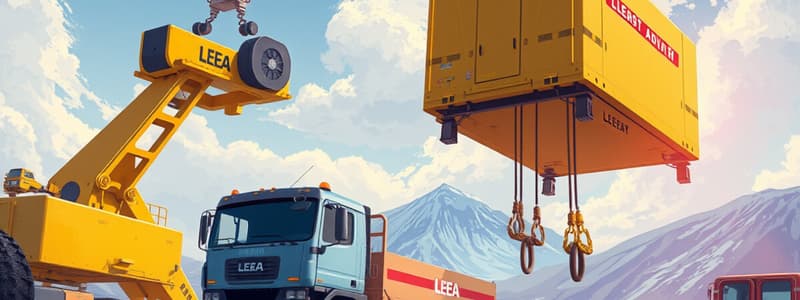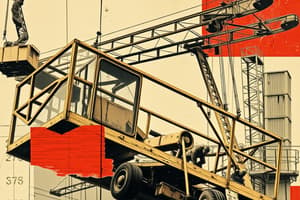Podcast
Questions and Answers
What is included in the verification process of lifting equipment?
What is included in the verification process of lifting equipment?
- Operator training programs
- Manufacturer's marketing strategy
- Proof load tests and thorough examinations (correct)
- User manuals and installation guides
What does a report of a thorough examination include?
What does a report of a thorough examination include?
- User feedback on the equipment
- Defects found or a statement of fitness for continued use (correct)
- Installation history of the equipment
- The manufacturer's warranty conditions
Who is responsible for issuing the report of thorough examination?
Who is responsible for issuing the report of thorough examination?
- The equipment operator
- The Competent Person (correct)
- The equipment manufacturer
- A third-party inspector
Why must the report of thorough examination be retained?
Why must the report of thorough examination be retained?
What does a proof load test assess in the context of lifting equipment?
What does a proof load test assess in the context of lifting equipment?
Which of the following is NOT a part of the verification procedures?
Which of the following is NOT a part of the verification procedures?
What kind of tests may be detailed in the report of a thorough examination?
What kind of tests may be detailed in the report of a thorough examination?
How might verification details be documented by manufacturers?
How might verification details be documented by manufacturers?
What is the primary characteristic of multipurpose equipment?
What is the primary characteristic of multipurpose equipment?
What does the rated capacity of a lifting appliance indicate?
What does the rated capacity of a lifting appliance indicate?
Who is responsible for applying the proof or test load?
Who is responsible for applying the proof or test load?
What distinguishes single purpose equipment from multipurpose equipment?
What distinguishes single purpose equipment from multipurpose equipment?
What was the previous term used for a report of test?
What was the previous term used for a report of test?
What kind of documents are test reports NOT considered when used independently?
What kind of documents are test reports NOT considered when used independently?
What is the role of the Operative?
What is the role of the Operative?
Why are proof load tests conducted for new lifting equipment?
Why are proof load tests conducted for new lifting equipment?
What does SWL stand for in the context of lifting equipment?
What does SWL stand for in the context of lifting equipment?
What is the function of the Working Load Limit (WLL)?
What is the function of the Working Load Limit (WLL)?
Under what condition might the SWL be lower than the WLL?
Under what condition might the SWL be lower than the WLL?
Which statement accurately distinguishes WLL from SWL?
Which statement accurately distinguishes WLL from SWL?
What is essential for a user to declare when ordering lifting equipment?
What is essential for a user to declare when ordering lifting equipment?
What does the term 'rated capacity' refer to?
What does the term 'rated capacity' refer to?
In which circumstances might the SWL be documented differently in various geographical regions?
In which circumstances might the SWL be documented differently in various geographical regions?
Which statement is true regarding SWL and rated capacity?
Which statement is true regarding SWL and rated capacity?
Which of the following is NOT considered a lifting appliance?
Which of the following is NOT considered a lifting appliance?
What is the role of a manufacturer regarding lifting equipment?
What is the role of a manufacturer regarding lifting equipment?
What document serves as the 'birth certificate' for a lifting product?
What document serves as the 'birth certificate' for a lifting product?
Which term defines the load below which a lifting equipment does not fail?
Which term defines the load below which a lifting equipment does not fail?
Which of the following best describes the minimum breaking load?
Which of the following best describes the minimum breaking load?
What is the primary piece of legislation for health and safety in the UK?
What is the primary piece of legislation for health and safety in the UK?
What do regulations regarding health and safety pertain to?
What do regulations regarding health and safety pertain to?
In the absence of a defined manufacturer, who is considered a manufacturer?
In the absence of a defined manufacturer, who is considered a manufacturer?
What typically needs to be retained as part of lifting equipment records?
What typically needs to be retained as part of lifting equipment records?
Which act serves as the primary health and safety legislation in the USA?
Which act serves as the primary health and safety legislation in the USA?
What does a manufacturer's certificate typically confirm?
What does a manufacturer's certificate typically confirm?
What is the purpose of standards as described in the content?
What is the purpose of standards as described in the content?
What does the term 'legislation' refer to?
What does the term 'legislation' refer to?
What aspect of health and safety is enforced by legislation?
What aspect of health and safety is enforced by legislation?
Which document is responsible for laying the framework for WHS in Australia?
Which document is responsible for laying the framework for WHS in Australia?
What is a characteristic of standards mentioned in the content?
What is a characteristic of standards mentioned in the content?
Flashcards
Lifting Equipment Legislation
Lifting Equipment Legislation
Rules and regulations governing lifting equipment set by countries like the UK, Australia, and the USA to ensure safe usage in the workplace.
UK's Health and Safety at Work Act
UK's Health and Safety at Work Act
A UK law that underpins safety regulations for all workplaces, including lifting equipment.
Australia's WHS Act
Australia's WHS Act
A model workplace health and safety law in Australia, adopted across various states.
OSHA Act (USA)
OSHA Act (USA)
Signup and view all the flashcards
Regulations (Lifting Equip.)
Regulations (Lifting Equip.)
Signup and view all the flashcards
Lifting Appliance Standards
Lifting Appliance Standards
Signup and view all the flashcards
Manufacturer's Responsibilities
Manufacturer's Responsibilities
Signup and view all the flashcards
Statements of Conformity
Statements of Conformity
Signup and view all the flashcards
Minimum Breaking Load
Minimum Breaking Load
Signup and view all the flashcards
Multipurpose Equipment
Multipurpose Equipment
Signup and view all the flashcards
Operative
Operative
Signup and view all the flashcards
Rated Capacity
Rated Capacity
Signup and view all the flashcards
Proof Load
Proof Load
Signup and view all the flashcards
Single Purpose Equipment
Single Purpose Equipment
Signup and view all the flashcards
Report of Test
Report of Test
Signup and view all the flashcards
Verification
Verification
Signup and view all the flashcards
Thorough Examination Report
Thorough Examination Report
Signup and view all the flashcards
Safe Working Load (SWL)
Safe Working Load (SWL)
Signup and view all the flashcards
Working Load Limit (WLL)
Working Load Limit (WLL)
Signup and view all the flashcards
Risk Assessment
Risk Assessment
Signup and view all the flashcards
Study Notes
Legislation Pertaining to Lifting Equipment
- Global legislative frameworks for lifting equipment vary by country; UK, Australia, and the USA set notable examples.
- UK’s Health and Safety at Work Act underpins the legislative framework focused on workplace safety.
- Australia follows the model WHS Act, adopted by various jurisdictions.
- The Occupational Safety and Health Act of 1970 serves as the primary legislation for workplace safety in the USA.
- Legislation consists of rules or directives enforced by authorities.
- Regulations are sets of rules applying to health and safety, varying by workplace type and industry.
Standards for Lifting Equipment
- Standards provide specifications ensuring consistency in product and service quality.
- Lifting appliances include cranes, hoists, and jacks which must adhere to established standards for operation.
Manufacturers Responsibilities
- Manufacturers, both natural and legal persons, are accountable for the design and compliance of lifting equipment.
- Manufacturer’s documents, like certificates or statements of conformity, validate that safety tests have been conducted.
- These documents serve as a "birth certificate" for the equipment, proving compliance with relevant standards and must be kept in equipment records.
Key Definitions in the Industry
- Minimum Breaking Load: The load limit below which equipment does not fail or release the load.
- Multipurpose Equipment: Equipment used for various loads within marked Safe Working Load (SWL) limits, not tailored to one specific application.
- Operative: A trained individual permitted to operate lifting equipment safely.
- Rated Capacity: The max gross load a lifting device can lift, often aligned with the Working Load Limit (WLL).
- Proof Load: A test load indicated by a competent person to assess equipment safety and performance.
- Single Purpose Equipment: Equipment designed for specific lifting tasks in defined capacities or environments.
- Report of Test: Issued by a competent person detailing the inspection results; may not stand alone without legal backing from other documentation.
- Verification: General practices ensuring lifting equipment meets legal safety standards, includes various testing methods.
Thorough Examination Reporting
- Reports from thorough examinations detail inspection findings and necessary tests performed.
- Essential to retain thorough examination reports as part of equipment maintenance records.
Working Load Limits (WLL) and Safe Working Load (SWL)
- SWL: Maximum load a piece of equipment can safely lift, defined by a competent person and marked on the equipment.
- WLL: Indicates the maximum load designed for the equipment; often considered synonymous with SWL.
- SWL values can vary based on the operational context and assessments carried out by competent individuals—documented on equipment records including statutory documentation.
Risk Assessment
- Risk assessments determine the necessity for load capacity adjustments, ensuring accurate SWL information governs equipment usage and compliance.
Studying That Suits You
Use AI to generate personalized quizzes and flashcards to suit your learning preferences.




